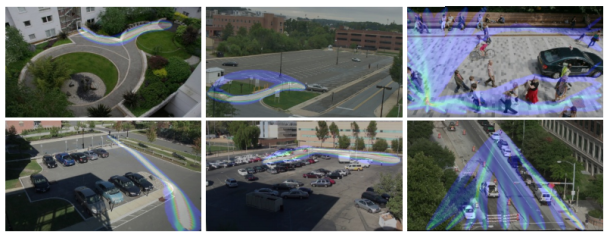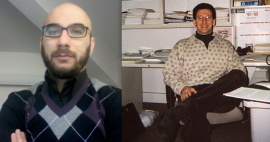Security cameras that watch you, and predict what you'll do next, sound like science fiction. But a team from Carnegie Mellon University says their computerized surveillance software will be capable of "eventually predicting" what you're going to do.

Computerized surveillance can predict what
people will do next -- it's called "activity forecasting" -- and
eventually sound the alarm if the action is not permitted. Click for
larger image.
(Credit:
Carnegie Mellon University)
Computer software programmed to detect and report illicit behavior could
eventually replace the fallible humans who monitor surveillance
cameras.
The U.S. government has funded the development of so-called automatic
video surveillance technology by a pair of Carnegie Mellon University
researchers who disclosed details about their work this week --
including that it has an ultimate goal of predicting what people will do
in the future.
"The main applications are in video surveillance, both civil and military," Alessandro Oltramari, a postdoctoral researcher at Carnegie Mellon who has a Ph.D. from Italy's University of Trento, told CNET yesterday.
Oltramari and fellow researcher Christian Lebiere
say automatic video surveillance can monitor camera feeds for
suspicious activities like someone at an airport or bus station
abandoning a bag for more than a few minutes. "In this specific case,
the goal for our system would have been to detect the anomalous
behavior," Oltramari says.
Think of it as a much, much smarter version of a red light camera: the
unblinking eye of computer software that monitors dozens or even
thousands of security camera feeds could catch illicit activities that
human operators -- who are expensive and can be distracted or sleepy --
would miss. It could also, depending on how it's implemented, raise
similar privacy and civil liberty concerns.

Alessandro Oltramari, left, and Christian
Lebiere say their software will "automatize video-surveillance, both in
military and civil applications."
(Credit:
Carnegie Mellon University)
A paper (PDF)
the researchers presented this week at the Semantic Technology for
Intelligence, Defense, and Security conference outside of Washington,
D.C. -- today's sessions are reserved
only for attendees with top secret clearances -- says their system aims
"to approximate human visual intelligence in making effective and
consistent detections."
Their Army-funded research, Oltramari and Lebiere claim, can go further
than merely recognizing whether any illicit activities are currently
taking place. It will, they say, be capable of "eventually predicting"
what's going to happen next.
This approach relies heavily on advances by machine vision researchers,
who have made remarkable strides in last few decades in recognizing
stationary and moving objects and their properties. It's the same vein
of work that led to Google's self-driving cars, face recognition software used on Facebook and Picasa, and consumer electronics like Microsoft's Kinect.
When it works well, machine vision can detect objects and people -- call
them nouns -- that are on the other side of the camera's lens.
But to figure out what these nouns are doing, or are allowed to do, you
need the computer science equivalent of verbs. And that's where
Oltramari and Lebiere have built on the work of other Carnegie Mellon
researchers to create what they call a "cognitive engine" that can
understand the rules by which nouns and verbs are allowed to interact.
Their cognitive engine incorporates research, called activity
forecasting, conducted by a team led by postdoctoral fellow Kris Kitani,
which tries to understand what humans will do by calculating which
physical trajectories are most likely. They say their software "models
the effect of the physical environment on the choice of human actions."
Both projects are components of Carnegie Mellon's Mind's Eye
architecture, a DARPA-created project that aims to develop smart cameras
for machine-based visual intelligence.
Predicts Oltramari: "This work should support human operators and automatize
video-surveillance, both in military and civil applications."


